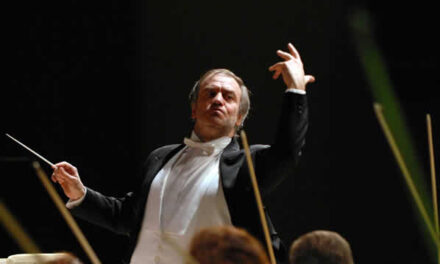The Daedalus Quartet took the large audience at the Watson Recital Hall on the campus of the University of North Carolina School of the Arts on a soaring tour no less impressive than its namesake’s mythical tour of the Aegean and the Mediterranean. Starting with a late Mozart quartet and ending with late Beethoven, the concert also featured the Carolina premiere of UNCSA faculty composer Lawrence Dillon’s fourth string quartet, The Infinite Sphere.
As a genre, the string quartet is perhaps the most sublime creation the evolution of music has produced: four similar sounding voices with warmth, expressivity and homogeneity far beyond any other example in wide use in the music domain, with the possible exception of the vocal quartet and chorus. The quartet composer must write a successful composition in itself, devoid of devices, gimmicks, colors or effects. Certainly, the organ and the orchestra, with their widely varied palettes of color and their extreme dynamic range put many more possibilities at the disposal of the composer, but the author of a string quartet must rely on his genius as a composer to write a successful string quartet.
If Haydn gave form of the string quartet, Mozart carried it forward, and Beethoven innovated and expanded it. Schubert, Mendelssohn, Brahms, Dvořák, Leos Janáček, Schönberg, Bartók and Elliot Carter, among others, have all added new dimensions to the shape of the string quartet. Yet it remains sovereign, a form of its own.
The opening of the concert might have reminded the listener of the implications of the name Daedalus, the mythically superb craftsman, inventor, discoverer and architect of the legendary Labyrinth of Crete, but perhaps better known for his ability to maintain a balance between flying too high (the sun’s heat would melt his wings, as it did his son’s, Icarus) and too low (water-logged wings would sink him).
The Daedalus Quartet maintained a superb balance between keenly disciplined playing, passionate tone and intensely personal expressivity, as in the predilection of the cellist, Raman Ramakrishnan, to add gentle portamentos (slides) and rubato (rhythmic flexibility) to the second theme of the opening Allegro of the Mozart Quartet, No. 22 in B-flat, K. 589. The charming Larghetto that followed ended with the viola (Jessica Thompson) playing triplets with the gentlest brush-stroke imaginable. As tradition would have it, the third movement of most quartets in the Classical period is a Minuet, which usually includes a contrasting Trio before the Minuet is repeated. This Trio is remarkable because of the dramatic intensity given it by Mozart, causing it to become far more important than its enclosing Minuet. And a bouncing finale in 6/8 closes this unusual quartet.
Brother and sister Min-Young Kim and Kyu-Young Kim swapped places as first and second violin in Larry Dillon’s quartet. Broadly couched in two distinct movements, seven “ROUND/RONDO” segments pay tribute to one of the more important forms of classical music. Originally derived from the simple folk rounds with recurring refrains, the rondo, in the hands of a Haydn or a Mozart, became a sophisticated form frequently used to close a sonata, quartet or a symphony. Often cheerful in nature, a theme alternates with other similar or contrasting themes.
Although complex and unpredictable, this work, String Quartet No. 4: The Infinite Sphere (2009) is not a difficult work to listen to, and upon rehearing might prove to be quite engaging. The first movement is subdivided into four segments; the first with the recurring “papadum” rhythm, leading into a bluegrass-inspired moment and then to some calm harmonics before yielding to a wild fugal passage reminiscent of some of the hyper-frenetic pages of Hector Berlioz. The second movement begins quietly with tremolos before building in complexity and with increasing chromaticism to a fevered climax, then subsiding suddenly and closing with a sigh. The four musicians were committed advocates for the composer and gave a very convincing performance!
The major work of the evening, filling the entire second half of the program, was the monumental Quartet, Op. 131, in C-sharp minor by Beethoven, called the 14th quartet, but actually 15th in order of composition. Written in seven numbered movements, this colossus seems disjointed and complicated, but upon study, reveals many unifying thematic elements. The Belgian art collector, Henri Desguin, once remarked that late Beethoven seems to be “stitched together with white thread” (“cousu de fil blanc”), a reference to the sudden shifts of harmony or key or mood which unexpectedly interrupt the listener.
Here again, the Daedalus Quartet spoke and breathed as one – with intense concentration and dedication to Beethoven. The most familiar passage, the Presto fifth movement, was absolutely brilliant, and the lengthy seventh movement, with its long passages of dotted rhythm reminded one of the closing of the previous quartet (AKA Grosse Fuge). The audience gave a long and warm ovation to these four outstanding musicians. We hope to hear them again soon.











